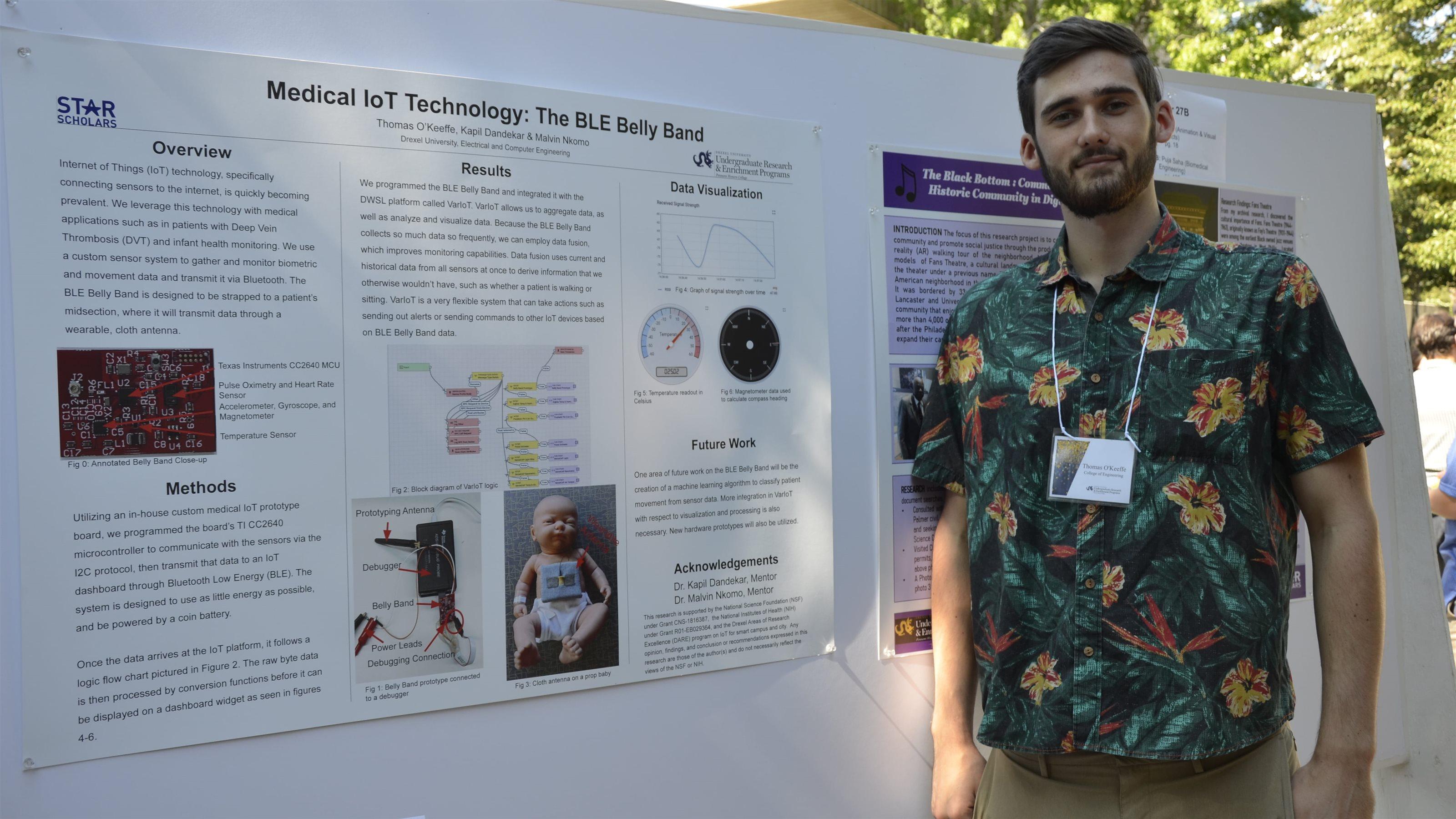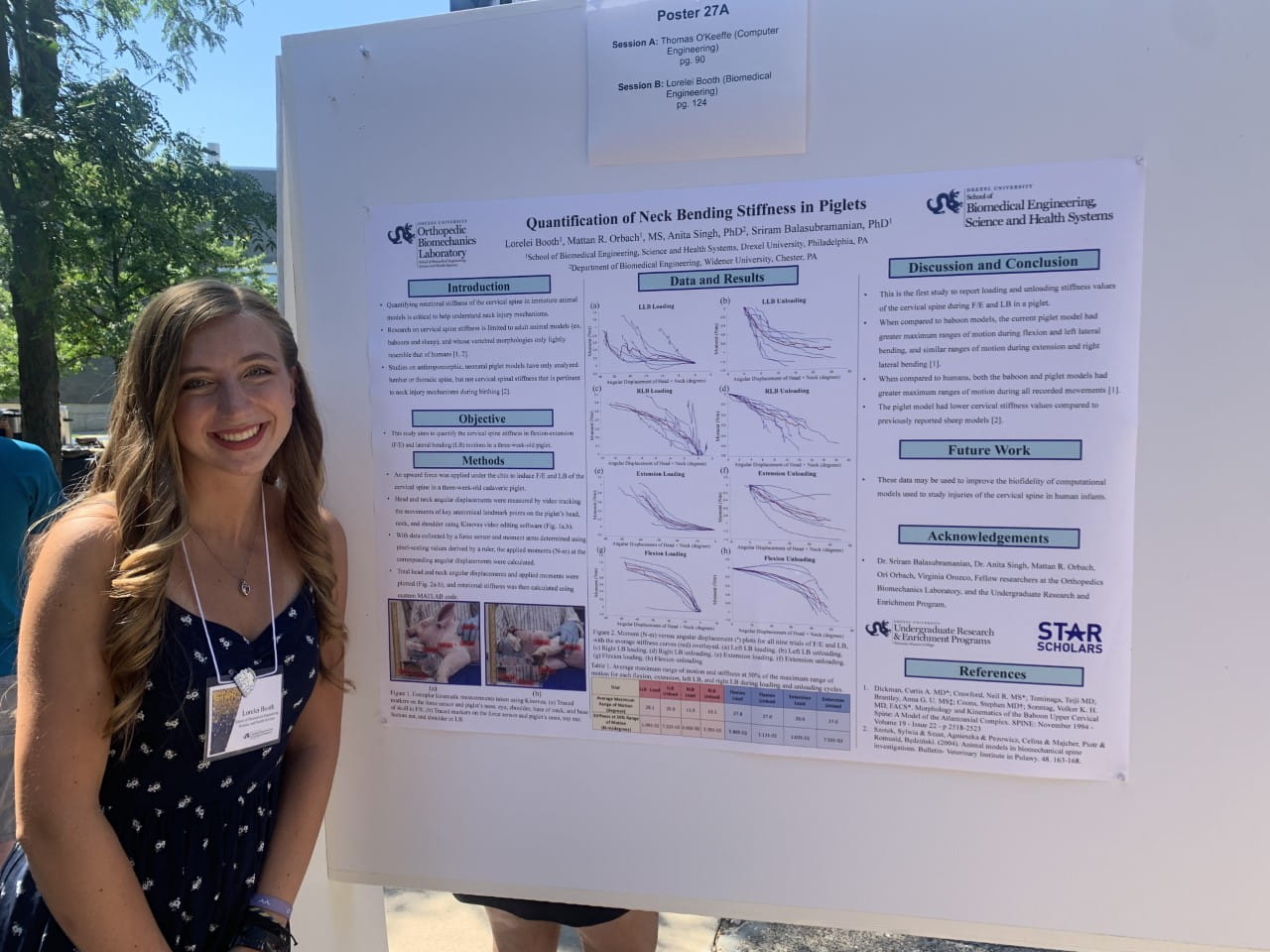STAR Scholars Shine in 20th Anniversary of Undergraduate Research Program

The showcase was held on Lancaster Walk, where students presented their findings in two groups of about 60.
Even though it was the middle of the day, on Aug. 25 on Lancaster Walk, dozens of stars shone brightly — or, more specifically, STARs. The 20th anniversary of the STAR Scholar Showcase brought more than 120 students to the same spot on Drexel University’s campus to show off their research projects they’d spent the summer term working on.
“I really love having this event outdoors,” said Emily Kashka-Ginsburg, associate director of Undergraduate Research & Enrichment Program. “The energy is always there for the showcase. It’s a fantastic day, our students are excited, the guests are excited, and it’s great to see what our students have accomplished in just 10 weeks. The showcase is the culmination of a lot of hard work.”
STAR Scholars are “Students Tackling Advanced Research,” and the program is through Pennoni Honors College. Students at the end of their first year, who aren’t yet on co-op, work closely with faculty mentors and take on research projects within their fields. Though research tends to skew towards STEM fields, Jaya Mohan, director of Undergraduate Research & Enrichment Programs, said they bring in students from all over the university.
“Research is about knowledge creation in their field, so it’s available to everybody,” Mohan said. “It’s about giving the students the opportunity to experience that knowledge creation.”
This was the second year the showcase has been hosted outdoors, and though it was a change brought about by the ongoing coronavirus pandemic, Mohan and Kashka-Ginsburg said it brings something new to the experience, because people just strolling by are brought in by the smorgasbord of boards.
The outdoor experience may be new, but the STAR program has been around for a long time. This year was the 20th anniversary of the first research cohort. To celebrate, Mohan and Kashka-Ginsburg brought in program alumni from throughout its history and hosted a weekly lecture series that focused on the impact of the program and how it has helped students launch their careers. One current faculty member, Kara Spiller, PhD, associate professor in the School of Biomedical Engineering, Science and Health Systems, was a student in the first cohort and mentored a scholar this year.
“It’s a pretty big milestone and we’re really excited about it,” Mohan said. “Every time I talk about it in front of our students, I’m like, ‘This program is older than you are.’ We’re proud of the legacy of the STAR Scholars Program and how impactful it’s been for our students, our faculty and the university as a whole.”
This year, three students who presented during the showcase gave the rundown on their research.

Thomas O’Keeffe
Thomas O’Keeffe, who worked in the Drexel Wireless Systems Laboratory with post-doctoral researcher Malvin Nkomo, drew passers-by in with his baby doll prop. His research on a device called the Belly Band has many applications, but he tried to make it easy for interested people to understand with a visual prop that actually wore a prototype of the Belly Band.
O’Keeffe programmed a circuit board that has a wake-on-move function and can quickly notify nurses or caretakers if there is movement — or lack thereof — in a patient. To make the Belly Band, O’Keeffe utilized a wearable cloth antenna created by Drexel’s Functional Fabrics Laboratory.
“It’s useful for patients that have a sensitivity to movement in their condition,” O’Keeffe said. “For instance, if a premature baby in the NICU rolls over, their ribcage might collapse. … Another application we’re looking at is for deep vein thrombosis [DVT], which is a condition that causes a pulmonary embolism, or a blood clot. It affects about 900,000 people each year, and in about 25 percent of patients, it’s lethal.”
If a premature baby moves too much, it’s bad. If a DVT patient doesn’t move enough, it’s bad, because they are at risk of developing blood clots. Some DVT patients are bedridden and connected to a device that will massage their deep veins for them, but there are some patients who are in-between being well enough to get exercise themselves and struggling to do so.
“The Belly Band can employ a technique called data fusion using our servers, and that allows you to take a whole bunch of data and mash it all together,” O’Keeffe said. “Using a machine learning algorithm, you can determine new data from the old data that we didn’t totally have, like if they’ve exercised enough or if they’re walking or sitting. You can send an alert to say they need to do some physical therapy, or you can use neuromuscular electrical stimulation and attach electrodes to the legs to manually stimulate the muscles.”
The point is that the Belly Band can make it easier for more DVT patients to avoid a bedridden state without much oversight. The device is closed circuit and runs itself, O’Keeffe said.
“You strap on the board, you set up the server and then it just goes,” O’Keeffe said. “There are a lot of different applications.”
The actual machine learning algorithm to determine new data is far off, but O’Keeffe’s research also included writing code to interpret the raw data that comes off the Belly Band’s board. There is still much to do to make it a usable, working technology, and O’Keeffe hopes to pick up where he left off even after his STAR program ends.

Lorelei Booth
Lorelei Booth
Over her summer, Lorelei Booth learned, among other things, that a three-week-old piglet has a similar neck to a newborn baby. Booth worked in Drexel’s Orthopedic Biomechanics Laboratory and studied neonatal brachial plexus palsy with Sriram Balasubramanian, PhD, associate professor in the School of Biomedical Engineering, Science and Health Systems.
“It’s a birthing injury in which the newborn’s neck is overstretched to one side, and nerves can be torn,” Booth said. “Because of that, these infants are often born with different forms of limb paralysis. What we’re trying to do is find what the stiffness was in the necks of these newborns, but as you can imagine, you can’t really do tests on newborn babies.”
Newborn baby pigs are a bit more hardy than newborn baby humans, so Booth and her mentors collected data tracking movement as the pigs moved their heads, neck directions and force as they moved. They were able to plot that data and find “stiffness curves,” which are solid values of how stiff the pigs’ necks are.
“This is the first study to collect this data, and we’re hoping to apply these stiffness values to models that repeat the birthing process so you can see how much stiffness is in the neck,” Booth said. “Spinal research regarding newborns is very limited, because you can’t really test, but there are a lot of instances where their necks could be compromised, so we’re hoping to use these stiffness values and apply it to models that can simulate these situations and prevent them from happening in the future.”
Booth had been interested in spinal and scoliotic research and has been shadowing Balasubramian in his lab since November 2021. He proposed the project to Booth and she really liked the idea, so she ran with it. She plans to submit her research to several conferences and repeat her process with piglets of other ages. Once she has enough data, she’ll be able to publish information about her findings.
“I learned a lot of patience during my STAR experience,” Booth said. “You find out just how long a study like this actually takes, and you’re trying new things and you have to persist. I had to not be afraid to ask for help and realize that I’m not going to know all of this, but I have people who do, so I can use my resources.”
Drexel News is produced by
University Marketing and Communications.

